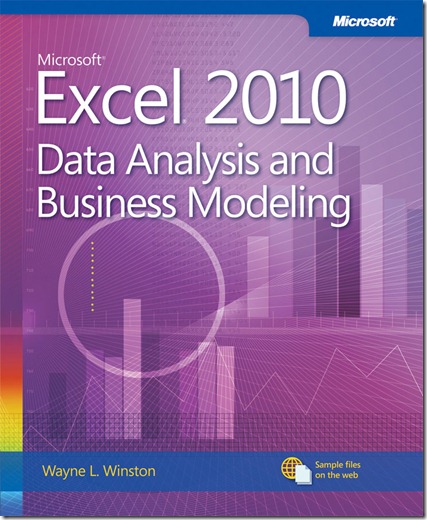RTM’d today: Microsoft Excel 2010: Data Analysis and Business Modeling
We’re happy to announce that Microsoft Excel 2010: Data Analysis and Business Modeling, by Wayne L. Winston, shipped to the printer. Award-winning MBA professor, statistician, and business consultant Wayne Winston shows you how to master the data analysis and modeling techniques used at leading companies to sharpen their competitive edge. This book will be available soon, but in the meantime here are the Table of Contents and an excerpt from the Introduction.
Table of Contents
1 What’s New in Excel 2010
2 Range Names
3 Lookup Functions
4 The INDEX Function
5 The MATCH Function
6 Text Functions
7 Dates and Date Functions
8 Evaluating Investments by Using Net Present Value Criteria
9 Internal Rate of Return
10 More Excel Financial Functions
11 Circular References
12 IF Statements
13 Time and Time Functions
14 The Paste Special Command
15 Three-Dimensional Formulas
16 The Auditing Tool
17 Sensitivity Analysis with Data Tables
18 The Goal Seek Command
19 Using the Scenario Manager for Sensitivity Analysis
20 The COUNTIF, COUNTIFS, COUNT, COUNTA, and COUNTBLANK Functions
21 The SUMIF, AVERAGEIF, SUMIFS, and AVERAGEIFS Functions
22 The OFFSET Function
23 The INDIRECT Function
24 Conditional Formatting
25 Sorting in Excel
26 Tables
27 Spin Buttons, Scroll Bars, Option Buttons, Check Boxes, Combo Boxes, and Group List Boxes
28 An Introduction to Optimization with Excel Solver
29 Using Solver to Determine the Optimal Product Mix
30 Using Solver to Schedule Your Workforce
31 Using Solver to Solve Transportation or Distribution Problems
32 Using Solver for Capital Budgeting
33 Using Solver for Financial Planning
34 Using Solver to Rate Sports Teams
35 Warehouse Location and the GRG Multistart and Evolutionary Solver Engines
36 Penalties and the Evolutionary Solver
37 The Traveling Salesperson Problem
38 Importing Data from a Text File or Document
39 Importing Data from the Internet
40 Validating Data
41 Summarizing Data by Using Histograms
42 Summarizing Data by Using Descriptive Statistics
43 Using PivotTables and Slicers to Describe Data
44 Sparklines
45 Summarizing Data with Database Statistical Functions
46 Filtering Data and Removing Duplicates
47 Consolidating Data
48 Creating Subtotals
49 Estimating Straight Line Relationships
50 Modeling Exponential Growth
51 The Power Curve
52 Using Correlations to Summarize Relationships
53 Introduction to Multiple Regression
54 Incorporating Qualitative Factors into Multiple Regression
55 Modeling Nonlinearities and Interactions
56 Analysis of Variance: One-Way ANOVA
57 Randomized Blocks and Two-Way ANOVA
58 Using Moving Averages to Understand Time Series
59 Winters’s Method
60 Ratio-to-Moving-Average Forecast Method
61 Forecasting in the Presence of Special Events
62 An Introduction to Random Variables
63 The Binomial, Hypergeometric, and Negative Binomial Random Variables
64 The Poisson and Exponential Random Variable
65 The Normal Random Variable
66 Weibull and Beta Distributions: Modeling Machine Life and Duration of a Project
67 Making Probability Statements from Forecasts
68 Using the Lognormal Random Variable to Model Stock Prices
69 Introduction to Monte Carlo Simulation
70 Calculating an Optimal Bid
71 Simulating Stock Prices and Asset Allocation Modeling
72 Fun and Games: Simulating Gambling and Sporting Event Probabilities
73 Using Resampling to Analyze Data
74 Pricing Stock Options
75 Determining Customer Value
76 The Economic Order Quantity Inventory Model
77 Inventory Modeling with Uncertain Demand
78 Queuing Theory: The Mathematics of Waiting in Line
79 Estimating a Demand Curve
80 Pricing Products by Using Tie-Ins
81 Pricing Products by Using Subjectively Determined Demand
82 Nonlinear Pricing
83 Array Formulas and Functions
84 PowerPivot
Introduction
Excerpt
Whether you work for a Fortune 500 corporation, a small company, a government agency, or a not-for-profit organization, if you’re reading this introduction the chances are you use Microsoft Excel in your daily work. Your job probably involves summarizing, reporting, and analyzing data. It might also involve building analytic models to help your employer increase profits, reduce costs, or manage operations more efficiently.
Since 1999, I’ve taught thousands of analysts at organizations such as 3M, Bristol-Myers
Squibb, Cisco Systems, Drugstore.com, eBay, Eli Lilly, Ford, General Electric, General Motors, Intel, Microsoft, NCR, Owens Corning, Pfizer, Proctor & Gamble, Tellabs, the U.S. Army, the U.S. Department of Defense, and Verizon how to use Excel more efficiently and productively in their jobs. Students have often told me that the tools and methods I teach in my classes have saved them hours of time each week and provided them with new and improved approaches for analyzing important business problems. Most of these classes used Excel 2003 or Excel 2007. With the added power of Excel 2010, you can be more productive than you ever dreamed! To paraphrase Alicia Silverstone in the movie Clueless, Excel 2007 is so five years ago.
I’ve used the techniques described in this book in my own consulting practice to solve many business problems. For example, I use Excel to help the Dallas Mavericks NBA basketball team evaluate referees, players, and lineups. During the last 15 years I have also taught Excel business modeling and data analysis classes to MBA students at Indiana University’s Kelley School of Business. (As proof of my teaching excellence, I have won BA teaching awards for 25 consecutive years, and have won the school’s overall MBA teaching award five times.) I would like to also note that 95 percent of MBA students at Indiana University take my spreadsheet modeling class even though it is an elective.
